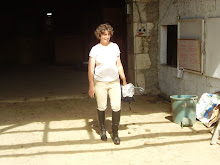How
to read with students
Research,
intuition and experience agree that students who read extensively in their
second language acquire more vocabulary and better grammatical skills than
students who don’t read.
The problem is
getting them to read. Many teachers
assign reading as homework and expect their students to come to class prepared
to discuss the text that they read at home.
Students who can not answer questions about the passage have obviously
not done their homework. So the class
discussion is limited to those few who actually read and understood the assigned
passage. In the world of TPRS they are
called 4%ers, the estimated percentage of American high school students who
begin the study of a foreign language and carry through for four years.
Yet it is
apparent that for many students the assigned passage was mission
impossible. They have neither the skills
nor the confidence needed to wade their way through what appears to be a
totally incomprehensible text. Yes,
there are strategies that can help them guess at the meaning of words, but the
strategies depend on the existence of meaningful context. The experts say that for students to read
with pleasure and understanding, they must recognize at least nine out of ten
words. And discouraged students often
fail to recognize even familiar words through lack of contextual clues.
Reading is an
important element in the TPRS method.
The “R” of TPRS stands for Reading and it is the third and final step of
the three steps that Blaine Ray defined as TPRS. Reading texts that are at an
appropriate level furnishes the comprehensible input which is essential to
acquiring the language.
So how do we read with TPRS? First the
teacher must choose a text with care so that the unknown vocabulary is
limited. She can use a class story that
she has typed up, or a variant from another class or her own version. It’s also possible to start with the text and
backward plan the first two steps of TPRS to prepare the students to read it.
It may require two or three sessions of PQA and Story if the passage contains a
lot of new vocabulary. Low frequency vocabulary that is not essential to
comprehension can be eliminated or replaced with more common words.
If the passage
still seems daunting to students, the teacher may decide to make an embedded
reading out of it. She writes up a very
brief summary of the main points as the first version, then adds details to
obtain a second version and more details for a third version.
We read with
the students, translating the text orally. Since Reading is the final step, the
students have been hearing the new structures repeatedly since they were first presented and then circled throughout the PQA and Story step. The new
structures should look familiar by now and we can ask the class to do a choral
translation. Or let individual students
propose their translation. Whenever
there is a tricky word the teacher supplies it as soon as she sees her students
hesitate. She may or may not decide to
circle the problem structure depending on how useful she feels it is.
I used to
believe that I should be circling the target structures during the reading,
although this felt rather laborious, having circled them so often in the
preceding steps. I now know that there
are more interesting ways of getting in those added repetitions. Also, this required constant switching
between languages. Personally, if we are
going to translate, I prefer to save the questions in L2 for later.
Blaine Ray suggests
working on a parallel story by comparing a student to a character in the
story. This can be effective, but it
depends on the character’s situation which often is not comparable to a student’s. Or at least we hope not.
Jody, on Ben
Slavic’s Professional Learning Community, recently shared her method of further
exploiting the reading. After they have
translated a paragraph or more, she has a student sit at the front of the class,
pretending to be a character in the story and the other students interview
him. He is free to answer as he pleases,
so it becomes a kind of parallel story, but the student controls where he wants
to go with it. Jody stops it whenever she feels that it’s appropriate, giving a
good hand of applause to the student/character, and they either translate
another paragraph or she calls on another student to play a different character.
I think this is an excellent activity and will definitely be using it in the
future.
Susie Gross
explains that she often read novels with her students “lickety-split”. That is, as the end of the school year
approached, she would read an entire novel with her students. It would be a TPRS novel with limited
vocabulary and level appropriate. She
did no additional activities and she did not ask questions to test their
comprehension. She did nothing to
pre-teach new vocabulary. They simply
translated the entire novel, decoding it paragraph by paragraph for the
pleasure of the story. Susie anticipated
when they would not know a word and furnished it without letting the suspense
build up. In less than two weeks the students would have read an entire novel
and felt very proud of themselves. They
enjoyed reading “lickety-split” so much that one boy told her he didn’t like to
read in English, but he loved reading in French.
A follow-up
activity to a reading is the dictée. I’m
talking about the classical French dictée.
The teacher reads the text three times as the students write it
down. Ben Slavic explains this in detail
on his site. It’s a very good way to fix
those structures in the students’ minds once and for all.
So there are
several approaches to Reading in TPRS and the teacher can choose the one that
suits her and her class best.
